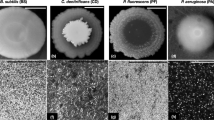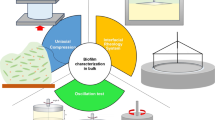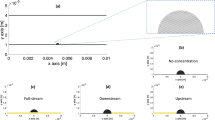Abstract
A current trend in biofilm research uses viscoelasticity to evaluate biological mechanisms used to adapt to environmental changes. However, due to un-quantified variability in mechanical properties, it is difficult to make comparisons between different growth conditions, strains, or species. To interpret biofilm viscoelasticity requires understanding its statistical variance divorced from experimental technique. In this work, 23 P. aeruginosa biofilms at air/water interfaces are characterized using an interfacial rheometer. This provides the least disturbance to the biofilm, allowing a truer sense of biological variability. Experiments were conducted in 3 sets in 2 different labs. Moduli varied 1 order of magnitude within a single set. Statistical analysis confirms that under seemingly identical growth conditions, viscoelastic moduli were different based on experiment location, which is attributed to minor changes in ambient conditions. Understanding this variance will lead to a better evaluation and comparison of biofilm formation in future studies.





Similar content being viewed by others
References
Abbasnezhad H, Gray M, Foght JM (2011) Influence of adhesion on aerobic biodegradation and bioremediation of liquid hydrocarbons. Appl Microbiol Biotechnol 92:653–675
Ahad NA, Yin TS, Othman AR, Yaacob CR (2011) Sensitivity of normality tests to non-normal data. Sains Malaysiana 40:637–641
Azeredo J, Azevedo NF, Briandet R, Cerca N, Coenye T, Costa AR, Desvaux M, Di Bonaventura G, Hébraud M, Jaglic Z, Kačániová M, Knøchel S, Lourenço A, Mergulhão F, Meyer RL, Nychas G, Simões M, Tresse O, Sternberg C (2017) Critical review on biofilm methods. Crit Rev Microbiol 43:313–351
Bajaj S, Singh DK (2015) Biodegradation of persistent organic pollutants in soil, water and pristine sites by cold-adapted microorganisms: Mini review. Int Biodeterior Biodegradation 100:98–105
Baniasadi M, Zhe Xu, Gandee L, Yingjie Du, Hongbing Lu, Zimmern P, Minary-Jolandan M (2014) Nanoindentation of Pseudomonas aeruginosa bacterial biofilm using atomic force microscopy. Mater Res Express 1:045411
Belas R (2014) Biofilms, flagella, and mechanosensing of surfaces by bacteria. Trends Microbiol 22:517–527
Billings N, Birjiniuk A, Samad TS, Doyle PS, Ribbeck K (2015) Material properties of biofilms—a review of methods for understanding permeability and mechanics. Rep Prog Phys 78(3):036601
Bjarnsholt T, Jensen PO, Fiandaca MJ, Pedersen J, Hansen CR, Andersen CB, Pressler T, Givskov M, Hoiby N (2009) Pseudomonas aeruginosa biofilms in the respiratory tract of cystic fibrosis patients. Pediatr Pulmonol 44:547–558
Bol M, Ehret AE, Albero AB, Hellriegel J, Krull R (2013) Recent advances in mechanical characterisation of biofilm and their significance for material modelling. Crit Rev Biotechnol 33:145–171
Brooijmans RJW, Pastink MI, Siezen RJ (2009) Hydrocarbon-degrading bacteria: the oil-spill clean-up crew. Microb Biotechnol 2:587–594
Chew SC, Kundukad B, Seviour T, van der Maarel JR, Yang L, Rice SA, Doyle P, Kjelleberg S (2014) Dynamic remodeling of microbial biofilms by functionally distinct exopolysaccharides. mBio 5:e01536–e015314
Fuentes S, Mendez V, Aguila P, Seeger M (2014) Bioremediation of petroleum hydrocarbons: catabolic genes, microbial communities, and applications. Appl Microbiol Biotechnol 98:4781–4794
Garrett TR, Bhakoo M, Zhang Z (2008) Bacterial adhesion and biofilms on surfaces. Prog Nat Sci 18:1049–1056
Gordon VD, Davis-Fields M, Kovach K, Rodesney CA (2017) Biofilms and mechanics: a review of experimental techniques and findings. J Phys D Appl Phys 50:223002
Guélon T, Mathias J-D, Stoodley P (2011) Advances in biofilm mechanics. in, Biofilm highlights (Springer)
Hamilton WA (1985) Sulphate-reducing bacteria and anaerobic corrosion. Annu Rev Microbiol 39:195–217
Hao OJ, Chen JM, Huang Li, Buglass RL (1996) Sulfate-reducing bacteria. Crit Rev Environ Sci Technol 26:155–187
Heydorn A, Ersbøll BK, Hentzer M, Parsek MR, Givskov M, Molin S (2000) Experimental reproducibility in flow-chamber biofilms. Microbiology 146:2409–2415
Hollenbeck EC, Fong JCN, Lim JY, Yildiz FH, Fuller GG, Cegelski L (2014) Molecular Determinants of mechanical properties of V. cholerae biofilms at the air-liquid interface. Biophys J 107:2245–2252
Jeanson S, Floury J, Gagnaire V, Lortal S, Thierry A (2015) Bacterial colonies in solid media and foods: a review on their growth and interactions with the micro-environment. Front Microbiol 6
Johnston MT, Ewoldt RH (2013) Precision rheometry: Surface tension effects on low-torque measurements in rotational rheometers. J Rheol 57:1515–1532
Jones WL, Sutton MP, McKittrick L, Stewart PS (2011) Chemical and antimicrobial treatments change the viscoelastic properties of bacterial biofilms. Biofouling 27:207–215
Kanungo T, Mount DM, Netanyahu NS, Piatko CD, Silverman R, Wu AY (2002) An efficient k-means clustering algorithm: analysis and implementation. IEEE Trans Pattern Anal Mach Intell 24:881–892
Karadag D, Köroğlu OE, Ozkaya B, Cakmakci M (2015) A review on anaerobic biofilm reactors for the treatment of dairy industry wastewater. Process Biochem 50:262–271
Kenney S, Poper K, Chapagain G, Christopher GF (2013) Large deborah number flows around confined microfluidic cylinders. Rheol Acta 52:485–497
Klapper I, Rupp CJ, Cargo R, Purvedorj B, Stoodley P (2002) Viscoelastic fluid description of bacterial biofilm material properties. Biotechnol Bioeng 80(3):289–296
Klausen M, Heydorn A, Ragas P, Lambertsen L, Aaes-Jørgensen A, Molin S, Tolker-Nielsen T (2003) Biofilm formation by Pseudomonas aeruginosa wild type, flagella and type IV pili mutants. Mol Microbiol 48:1511–1524
Klockgether J, Munder A, Neugebauer J, Davenport CF, Stanke F, Larbig KD, Heeb S, Schöck U, Pohl TM, Wiehlmann L (2010) Genome diversity of Pseudomonas aeruginosa PAO1 laboratory strains. J Bacteriol 192:1113–1121
Kovach K, Davis-Fields M, Irie Y, Jain K, Doorwar S, Vuong K, Dhamani N, Mohanty K, Touhami A, Gordon VD (2017) Evolutionary adaptations of biofilms infecting cystic fibrosis lungs promote mechanical toughness by adjusting polysaccharide production. Biofilms Microbiomes 3:1
Kragh KN, Hutchison JB, Melaugh G, Rodesney C, Roberts AE, Irie Y, Jensen PØ, Diggle SP, Allen RJ, Gordon V, Bjarnsholt T (2016) Role of multicellular aggregates in biofilm formation. mBio 7(2)
Kragh KN, Alhede M, Rybtke M, Stavnsberg C, Jensen PØ, Tolker-Nielsen T, Whiteley M, Bjarnsholt T (2018) The inoculation method could impact the outcome of microbiological experiments. Appl Environ Microbiol 84
Lieleg O, Caldara M, Baumgartel R, Ribbeck K (2011) Mechanical robustness of Pseudomonas aeruginosa biofilms. Soft Matter 7:3307–3314
Mazza MG (2016) The physics of biofilms—an introduction. J Phys D Appl Phys 49:203001
Niepa THR, Vaccari L, Leheny RL, Goulian M, Lee D, Stebe KJ (2017) Films of Bacteria at Interfaces (FBI): Remodeling of Fluid Interfaces by Pseudomonas aeruginosa. Scientific Reports 7:17864
O'Toole GA, Ghannoum MA (2004) Introduction to biofilms: conceptual themes. Microbial Biofilms. American Society of Microbiology, p 1–3
O’Toole G, Kaplan HB, Kolter R (2000) Biofilm formation as microbial development. Annual Reviews in Microbiology 54:49–79
Parsek MR, Singh PK (2003) Bacterial biofilms: an emerging link to disease pathogenesis. Annual Reviews in Microbiology 57:677–701
Petrova OE, Sauer K (2016) Escaping the biofilm in more than one way: desorption, detachment or dispersion. Curr Opin Microbiol 30:67–78
Purevdorj-Gage B, Costerton WJ, Stoodley P (2005) Phenotypic differentiation and seeding dispersal in non-mucoid and mucoid Pseudomonas aeruginosa biofilms. Microbiology 151:1569–1576
Purevdorj B, William Costerton J, Stoodley P (2002) Influence of hydrodynamics and cell signaling on the structure and behavior of Pseudomonas aeruginosa biofilms. Appl Environ Microbiol 68:4457–4464
Qi L, Christopher GF (2019) Role of flagella, type IV Pili, biosurfactants, and extracellular polymeric substance polysaccharides on the formation of pellicles by Pseudomonas aeruginosa. Langmuir 35:5294–5304
Rogers SS, Van Der Walle C, Waigh TA (2008) Microrheology of bacterial biofilms in vitro: Staphylococcus aureus and Pseudomonas aeruginosa. Langmuir 24:13549–13555
Ruhs PA, Boni L, Fuller GG, Inglis RF, Fischer P (2013) In-Situ quantification of the interfacial rheological response of bacterial biofilms to environmental stimuli. PLoS ONE 8:9
Rühs PA, Böcker L, Inglis RF, Fischer P (2014) Studying bacterial hydrophobicity and biofilm formation at liquid–liquid interfaces through interfacial rheology and pendant drop tensiometry. Colloids Surf, B 117:174–184
Sauer K, Camper AK, Ehrlich GD, William Costerton J, Davies DG (2002) Pseudomonas aeruginosa displays multiple phenotypes during development as a biofilm. J Bacteriol 184:1140–1154
Shi X, Kenney S, Chapagain G, Christopher GF (2015) Mechanisms of onset for moderate mach number instabilities of viscoelastic flows around confined cylinders. Rheol Acta 54:805–815
Stewart PS (2014) Biophysics of biofilm infection. Pathogens and Disease 70:212–218
Stoodley P, Cargo R, Rupp CJ, Wilson S, Klapper I (2002) Biofilm material properties as related to shear-induced deformation and detachment phenomena. J Ind Microbiol Biotechnol 29:361–367
Stoodley P, Jacobsen A, Dunsmore BC, Purevdorj B, Suzanne Wilson HM, Lappin-Scott, and J William Costerton. (2001) The influence of fluid shear and AlCl3 on the material properties of Pseudomonas aeruginosa PAO1 and Desulfovibrio sp. EX265 biofilms. Water Science Technology 43:113–120
Stoodley P, Lewandowski Z, Boyle JD, Lappin-Scott HM (1999) Structural deformation of bacterial biofilms caused by short-term fluctuations in fluid shear: An in situ investigation of biofilm rheology. Biotechnol Bioeng 65:83–92
Vaccari L, Allan DB, Sharifi-Mood N, Singh AR, Leheny RL, Stebe KJ (2015) Films of bacteria at interfaces: three stages of behaviour. Soft Matter 11:6062–6074
Vandebril S, Franck A, Fuller GG, Moldenaers P, Vermant J (2010) A double wall-ring geometry for interfacial shear rheometry. Rheol Acta 49:131–144
Vissers T, Brown AT, Koumakis N, Dawson A, Hermes M, Schwarz-Linek J, Schofield AB, French JM, Koutsos V, Arlt J (2018) Bacteria as living patchy colloids: Phenotypic heterogeneity in surface adhesion. Sci Adv, 4: eaao1170
Wei Q, Ma LZ (2013) Biofilm matrix and its regulation in Pseudomonas aeruginosa. Int J Mol Sci 14:20983–21005
Wloka M, Rehage H, Flemming H-C, Wingender. (2005) Structure and rheological behaviour of the extracellular polymeric substance network of mucoid Pseudomonas aeruginosa biofilms. Biofilms 2:275–283
Wu C, Lim JY, Fuller GG, Cegelski L (2013) Disruption of Escherichia coli amyloid-integrated biofilm formation at the air–liquid interface by a polysorbate surfactant. Langmuir 29:920–926
Wu C, Lim JY, Fuller GG, Cegelski L (2012) Quantitative analysis of amyloid-integrated biofilms formed by Uropathogenic Escherichia coli at the air-liquid interface. Biophys J 103:464–471
Yang S, Cheng X, Jin Z, Xia A, Ni L, Zhang R, Jin F (2018) Differential production of Psl in planktonic cells leads to two distinctive attachment phenotypes in Pseudomonas aeruginosa. Appl Environ Microbiol 84:14
Zhang Z, Christopher G (2016) Effect of particulate contaminants on the development of biofilms at air/water interfaces. Langmuir 32:2724–2730
Zhang Z, Barman S, Christopher GF (2014) Effect of interfacial viscoelasticity on the bulk linear viscoelastic moduli of globular protein solutions. Phys Rev E 89:052306
Zoueki CW, Ghoshal S, Tufenkji N (2010) Bacterial adhesion to hydrocarbons: role of asphaltenes and resins. Colloids Surf, B 79:219–226
Acknowledgments
The authors would also like to thank Dr. Michael San Francisco of TTU, Dr. Kendra Rumbaugh of TTU HSC and Dr. Vernita Gordon of UT for all their help in supplying bacteria, educating the authors in bacteria culturing technique, and a wide range of useful discussions.
Funding
This work was funded by the NSF CMMI (#1635245).
Author information
Authors and Affiliations
Corresponding author
Additional information
Publisher’s note
Springer Nature remains neutral with regard to jurisdictional claims in published maps and institutional affiliations.
Rights and permissions
About this article
Cite this article
Qi, L., Christopher, G.F. Rheological variability of Pseudomonas aeruginosa biofilms. Rheol Acta 60, 219–230 (2021). https://doi.org/10.1007/s00397-021-01260-w
Received:
Revised:
Accepted:
Published:
Issue Date:
DOI: https://doi.org/10.1007/s00397-021-01260-w




